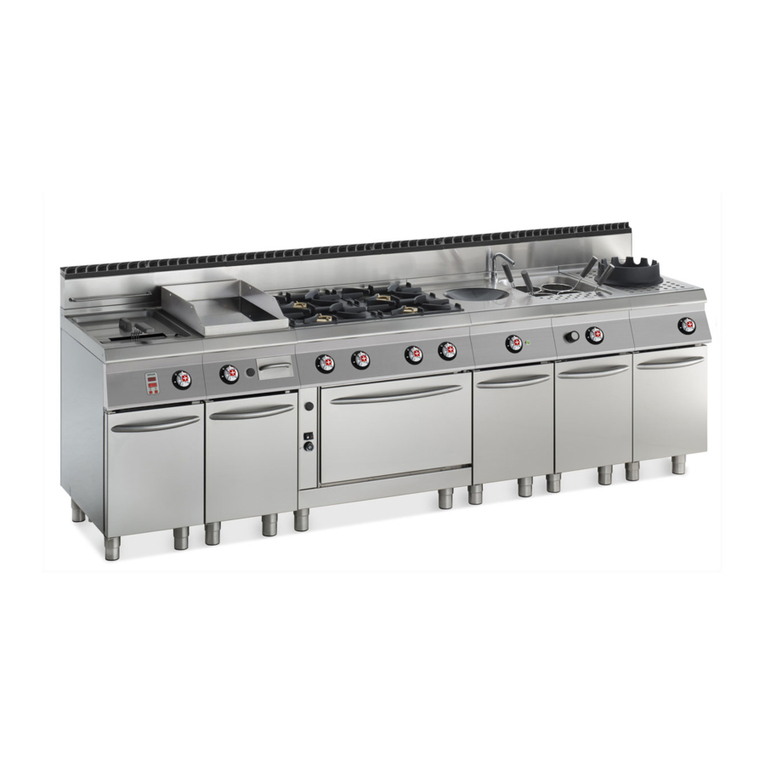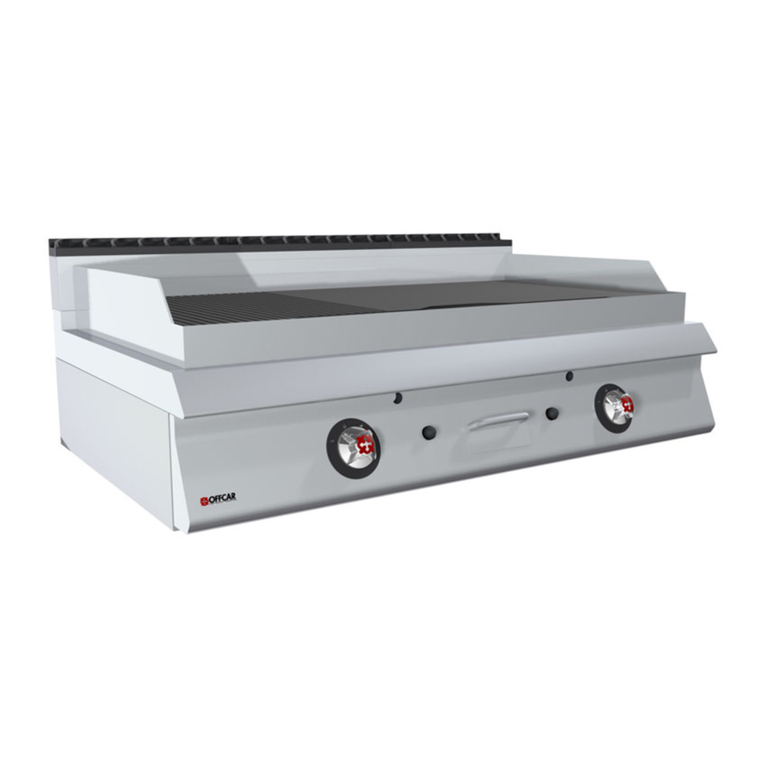
2
Vanno inoltre rispettate le disposizioni antincendio vigenti, i regolamenti edilizi e disposizioni antincendio locali, le norme
antinfortunistiche vigenti e le disposizioni dell’ente di erogazione del gas.
Non ostruire le aperture o fessure di aspirazione o di smaltimento del calore.
Onde evitare rischi di ossidazione o di aggressioni chimiche in genere, occorre tenere ben pulite le superfici in acciaio
inossidabile.
Pulire giornalmente le parti in acciaio inox con acqua tiepida saponata, quindi risciacquare abbondantemente ed
asciugare con cura.
possono depositare particelle ferrose che ossidandosi provocano punti di ruggine. Può essere eventualmente adoperata
lana di acciaio inossidabile nel senso di satinatura.
tutte le superfici in acciaio un panno imbevuto di olio di vaselina in modo da stendere un velo protettivo; inoltre arieggiare
periodicamente i locali.
Prima di procedere al collegamento controllare sulla targhetta tecnica che l’apparecchio sia stato collaudato ed
omologato per il tipo di gas a disposizione presso l’utente.
Nel caso che il tipo di gas indicato sulla targhetta non sia quello di cui si dispone, seguire le indicazioni nel paragrafo
La casa costruttrice declina ogni responsabilità per le possibili inesattezze contenute nel presente opuscolo imputabili ad
errori di trascrizione o stampa. Si riserva inoltre il diritto di apportare al prodotto quelle modifiche che ritiene utili o
necessarie, senza pregiudicarne le caratteristiche essenziali.
La ditta costruttrice declina ogni e qualsiasi responsabilità qualora non venissero strettamente osservate le norme
contenute in questo manuale.
i da errata installazione, manomissione
LO SMALTIMENTO DELLA MACCHINA, AL TERMINE DEL CICLO DI LAVORO, DEVE ESSERE EFFETTUATA IN
CONFORMITÀ ALLE NORMATIVE VIGENTI. LA MACCHINA DEVE ESSERE CONSEGNATA A PERSONALE
AUTORIZZATO PER IL RECUPERO E LO SMALTIMENTO DI PARTI DELLA STESSA.
2.1 Installazione dell’apparecchio
inconvenienti agli impianti, deve essere eseguita unicamente da personale qualificato, nel rispetto delle norme in vigore.
Gli impianti a gas, ed i locali di installazione degli apparecchi devono rispondere
alle regolamentazioni esistenti nelle varie zone ed in particolare si deve
ri a 2 m3/h
per ogni kW di potenza installata e che devono essere osservate le Norme
prevenzione infortuni.
2.2 Posa in opera degli apparecchi
provvedendo alla loro messa a bolla e regolazione in altezza mediante i piedini
regolabili o altri mezzi.
Togliere dai pannelli esterni la pellicola protettiva, staccandola lentamente per
impedire che rimanga il collante.
È contro il calore.
Interporre fogli refrattari oppure piazzare gli apparecchi da almeno 200 mm di
distanza dalle pareti laterali o posteriori.
2.3 Scarico fumi
Gli apparecchi devono essere installati in locali adatti per lo scarico dei prodotti della combustione che deve avvenire nel
rispetto di quanto prescritto dalle norme di installazione. Le nostre apparecchiature sono considerate (vedi tabella 1 dati
tecnici) come: APPARECCHI A GAS DI TIPO “A1”
Gli apparecchi di tipo A1 devono essere installati in locali sufficientemente ventilati per prevenire la concentrazione di
Gli apparecchi di tipo A1 non necessitano del collegamento diretto ad un condotto di scarico dei prodotti di combustione.
I prodotti della combustione però devono essere convogliati in apposite cappe o dispositivi similari, collegate ad un
direttamente in ambiente esterno, di portata non
le norme in vigore, indicativamente per un totale di 35 m³/h per ogni kW di potenza gas installata.
Evacuazione forzata sotto cappa. Nel caso di installazione sotto cappa, la parte terminale del condotto di scarico
sbocco dei condotti di scarico dei prodotti della combustione deve essere disposta entro il perimetro di base della cappa
forzata, e deve interrompersi nel caso che la portata di questo scenda sotto i valori prescritti dalla norma di installazione.
Fig. 1
Evacuazione forzata sottocappa






























